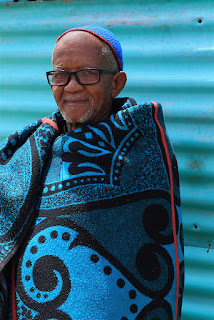The History of the Basotho Traditional Blanket
Lesotho people have their own ways of living. Transportation, healing, trading, clothing is very unique in many ways. Every village, every clan has its own totem animal which is sacred to them. They would put motives of such animals into many everyday items to reminds them self of its power and also to distinguished them selfs from others. Motives of clan's animal could be also seen on Traditional Basotho Blankets.
Nowadays the Basotho tribal blanket (Seanamarena) is such a common sight in Lesotho, that tourists tend to assume that it was a local invention. However, its origins can be traced back to the European traders and missionaries as far back as the 1800s. The popularity and assimilation of the blankets by the Basotho people can be traced back to one single incident.
A blanket was presented to the King Moshoeshoe I. in 1860 by a man by the name of Mr. Howel. The King was by all accounts quite taken with the blanket (“a handsome railway wrapper made of light blue pilot cloth, heavy and hairy”) and wore the blanket in preference to his then neglected traditional leopard skin karosses.
The blanket has become part of not only their everyday life but as a status symbol. To outsiders it became a mark of ethnicity and therefore a token of cultural identification. In fact Lesotho is the only nation south of the Sahara that illustrates the culture of an entire nation through such an individualistic item such as the tribal blanket.
Up to approximately 600 years ago furs, skins and even dried grass were used to keep out the cold during the winter months. By 1860 it was becoming more difficult to procure sufficient skins for Karosses and by 1872 many of the old sheepskin covers had been replaced by crudely made cotton or woollen blankets. Several historians and writers refer to natural disasters, such as continual droughts and the exceptionally cold winter of 1902 (the great snow), as well as the “Rinderpest” outbreak of 1897. These events depleted the wild and domestic animals of Lesotho and the disasters continued well into the twentieth century.
The visible stripes on the blankets are known as “pin-stripes”. According to historical records these 1cm stripes originally came about as a weavers fault. Instead of correcting this fault, the manufacturer shipped them with the “pin-stripe” which subsequently became a traditional feature.
The traditional blankets differ from most modern blankets in that they are almost entirely made of wool (88% wool and 12% cotton), hence their rougher and firmer texture.
Ceremonial uses for Lesotho blankets
Although blanket styles have been subject to outside influences, they are still to this day closely linked with the milestones of Basotho family life:
– Boys preparing for the circumcision ritual don a special fertility blanket known as a moholobela. After the ceremony he’s considered to have reached manhood, and wears another kind of blanket, called the lekhokolo.
– On the occasion of his wedding, a man wears a motlotlehi, and he presents his wife with a serope when their first child is born.
– Before her wedding day, a woman spends a great deal of time trying on and selecting blankets for her trousseau. Women’s blankets are quite different to men’s – they are designed to be pinned over their bosom whereas the men pin them to the right shoulder.
-There are also special occasions in the Basotho’s national life where blankets symbolize the particular event. For instance, on Independence Day or National Tree Planting Day, a man of substance may wear not one but three blankets, namely the Torch blanket, a Victoria and a Sandringham.


Absolutely! It's truly amazing how contemporary fashion has embraced the beauty of Basotho blankets, transforming them into stunning pieces that celebrate Lesotho's rich cultural heritage. Designers like Thabo Makhetha and Chulaap Suwaannapha have taken the traditional Basotho blanket and reimagined it into modern, stylish garments that pay homage to its history and significance.
ReplyDeleteIf you're intrigued by this fusion of tradition and contemporary fashion, I highly encourage you to check out more about it on www.moetlo.co.za . You'll be amazed by how these designers have seamlessly integrated the timeless elegance of Basotho blankets into the world of fashion.